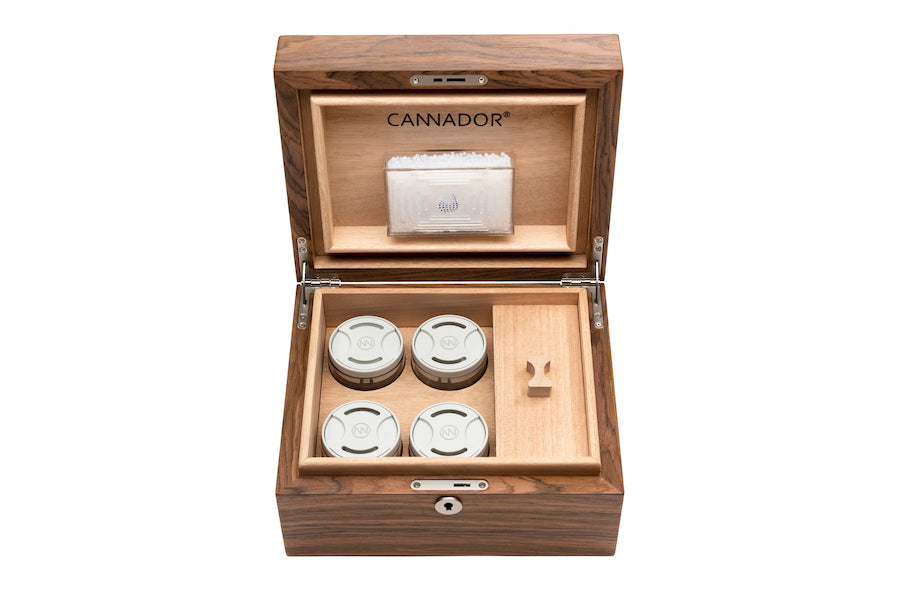How does a humidor work? There are two vital things that make a humidor work for your cannabis or tobacco and that would be the relative humidity (RH) and the interior wood. There are other factors like air-tightness and structure that also affect the quality of how your humidor will work.
What is a Humidor?
A humidor is a container, often made of wood that maintains a controlled level of humidity. It is primarily used for storing cigars or cannabis and its application extends to other items sensitive to humidity changes. The primary goal of a humidor is to keep the stored items at an ideal humidity level to prevent them from drying out or becoming too moist, both of which can negatively affect their quality.
How Does a Humidor Work?
At its core, a humidor works by regulating humidity through a combination of materials and mechanisms designed to control moisture levels. Here’s a breakdown of how it functions:
-
Humidification System: The heart of any humidor is its humidification system. This can come in various forms, including:
- Silica Gel Beads: Silica gel beads like the VaporBeads only require adding water and wick off moisture to the correct relative humidity. The beads have micro-pores that are impregnated with a salt based solution to maintain and balance the humidity.
- Sponges or Gel Packs: These are commonly used in simpler humidors. They absorb water and gradually release it into the air, maintaining the desired humidity level.
- Electronic Humidifiers: These advanced systems use electronic controls to regulate humidity precisely. They often come with digital displays and can adjust the moisture level automatically.
-
Hygrometer: A hygrometer is an instrument used to measure the humidity inside the humidor. There are two main types:
- Analog Hygrometers: These use a dial and needle to display humidity levels. They are reliable but may require calibration over time.
- Digital Hygrometers: These offer more precise readings and are easier to read. They often come with additional features, such as temperature readings.
-
Seal and Insulation: The effectiveness of a humidor greatly depends on its ability to maintain a sealed environment. Most humidors feature a tight seal to prevent air from escaping, which helps to stabilize humidity levels. The interior of the humidor is often lined with a special type of wood, such as Spanish cedar or mahogany, which not only helps regulate humidity but also imparts a pleasant aroma that complements cigars.
Types of Humidors
Humidors come in various types, each designed to meet different needs:
-
Desktop Humidors: These are the most common type and are often used by cigar enthusiasts. They typically range in size from small shoe-box size to mini-chest. Desktop humidors often come with built-in humidification systems and hygrometers.
-
Travel Humidors: Designed for portability, travel humidors are compact and usually made from durable materials. They are ideal for maintaining humidity during travel and often feature a small, efficient humidification system.
-
Cabinet Humidors: For serious collectors, cigar and cannabis cabinets offer larger storage solutions. These cabinets can hold hundreds of cigars and come with advanced humidification systems and multiple compartments.
Setting Up and Maintaining a Humidor
To ensure your humidor functions correctly, proper setup and maintenance are crucial. Here’s how to do it:
-
Seasoning the Humidor: Before you start using your humidor, it needs to be seasoned. This process involves moistening the interior wood to ensure it can effectively regulate humidity. Here’s how to do it:
- Wipe Down: Use a clean sponge or cloth to wipe down the interior of the humidor with distilled water. Avoid soaking the wood.
- Add Humidification: Place a humidification device inside the humidor and fill it with distilled water. Allow it to run for 24-48 hours.
- Check Humidity: Use the hygrometer to ensure that the humidity level is stable at around 65-70% for cigars and 55-65% for cannabis. If it fluctuates, continue the seasoning process until stable.
-
Storing Items: Once the humidor is seasoned and ready, place your cigars or other items inside. Make sure not to overcrowd the humidor, as this can impede air circulation and affect humidity levels.
-
Regular Maintenance: To keep your humidor in good working order:
- Monitor Humidity: Check the hygrometer regularly to ensure the humidity level remains within the desired range.
- Refill Humidification: Depending on the type of humidifier, you may need to refill it with distilled water or replace gel packs periodically.
- Clean the Humidor: Occasionally clean the interior with a soft cloth to remove dust and debris. Avoid using chemicals that can damage the wood.
-
Troubleshooting: If you encounter issues such as fluctuating humidity or mold, address them promptly:
- Fluctuating Humidity: This could be due to an improperly sealed humidor or an ineffective humidification system. Check the seal and the functionality of the humidifier.
- Mold: If mold appears, remove the affected items and clean the interior with a mixture of distilled water and vinegar. Ensure proper ventilation and humidity control.
Conclusion
A humidor is a vital tool for preserving the quality of cannabis and cigars which are sensitive to humidity. By understanding how a humidor works and properly maintaining it, you can ensure that your items remain in optimal condition, enhancing their flavor and longevity. Whether you're a casual user or a serious collector, investing in a high-quality humidor and following these guidelines will help you enjoy your cherished items at their best.




